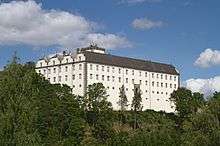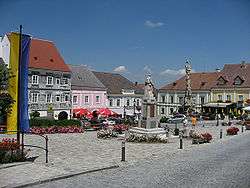Weitra
| Weitra | ||
|---|---|---|
|
Main square | ||
| ||
 Weitra Location within Austria | ||
| Coordinates: 48°42′N 14°54′E / 48.700°N 14.900°ECoordinates: 48°42′N 14°54′E / 48.700°N 14.900°E | ||
| Country | Austria | |
| State | Lower Austria | |
| District | Gmünd | |
| Government | ||
| • Mayor | Raimund Fuchs (ÖVP) | |
| Area | ||
| • Total | 52.53 km2 (20.28 sq mi) | |
| Elevation | 562 m (1,844 ft) | |
| Population (1 January 2016)[1] | ||
| • Total | 2,709 | |
| • Density | 52/km2 (130/sq mi) | |
| Time zone | CET (UTC+1) | |
| • Summer (DST) | CEST (UTC+2) | |
| Postal code | 3970 | |
| Area code | 02856 | |
| Website | www.weitra.gv.at | |
Weitra (Czech: Vitoraz) is a small town in the district of Gmünd in the Austrian state of Lower Austria.
Geography
It is located within the rural Waldviertel region on the upper Lainsitz (Lužnice) river, near the border with the Czech Republic. The municipality consists of the Katastralgemeinden Brühl, Großwolfgers, Oberwindhag, Reinprechts, Spital, St. Wolfgang, Sulz, Walterschlag, Weitra and Wetzles.
History

A first castle at Weitra was established in 1201 by the Austrian noble Hadmar II of Kuenring (or Kühnring), holder of Dürnstein castle, where King Richard the Lionheart had been imprisoned in winter 1192/93. The Kuenring family of ministeriales fell from grace after the extinction of the ruling House of Babenberg in 1246, as they had sided with King Ottokar II of Bohemia against the rising Habsburg dynasty. Ottokar II was defeated by the Habsburg king Rudolph I of Germany at the 1278 Battle on the Marchfeld, and Rudolph's son, Duke Albert I of Austria, finally acquired Weitra Castle in 1296. The fortress on the Bohemian border was seized by the Hussites as well as by Hungarian troops under Matthias Corvinus in 1486.
In 1581, Emperor Rudolf II enfeoffed Weitra to his chamberlain Wolf Rumpf. In 1607, Count Frederick IV of Fürstenberg-Heiligenberg, who had married Rumpf's widow, inherited the fief. During the Thirty Years' War, the castle was again attacked by Swedish forces under General Lennart Torstenson in 1645. The comital (from 1664 princely) House of House of Fürstenberg held Weitra until the Revolutions of 1848. The members of the Fürstenberg-Weitra cadet branch left a Renaissance castle erected on mediæval foundations, which was later rebuilt in a Baroque design. The castle was restored by the House of Fürstenberg in 1994.
Beside its historic textile industry, Weitra is known as the oldest beer-producing site in Austria with several breweries documented since the 14th century. In 1903, the town received access to a narrow gauge railway line to Gmünd, since 2001 run as a heritage railway. After World War II, the economy suffered from the town's peripheral location near the Iron Curtain. Since 1959, Weitra houses a garrison of the Austrian Armed Forces.
Politics
Seats in the municipal council (Gemeinderat) as of 2009 elections:
- Austrian People's Party (ÖVP): 15
- Social Democratic Party of Austria (SPÖ): 4
- WIR (Independent): 2
Notable people
- Klara Hitler née Pölzl (1860–1907), mother of Adolf Hitler, was born on 12 August 1860 in the hamlet of Spital. She was the daughter of Johanna Hiedler (1830−1906), a local peasantwoman, and by her maternal grandfather Johann Nepomuk Hiedler (1807−1888) a distant cousin of her later husband Alois Hitler from nearby Strones, Döllersheim. Alois Hitler also lived in Spital (1842-1850), raised by Johann Nepomuk Hiedler after he was abandoned by his mother as a five-year-old.
- Ludwig and Maria Knapp, owners of a sawmill and an agricultural farm in Weitra, Righteous Among the Nations.
References
| Wikimedia Commons has media related to Weitra. |

